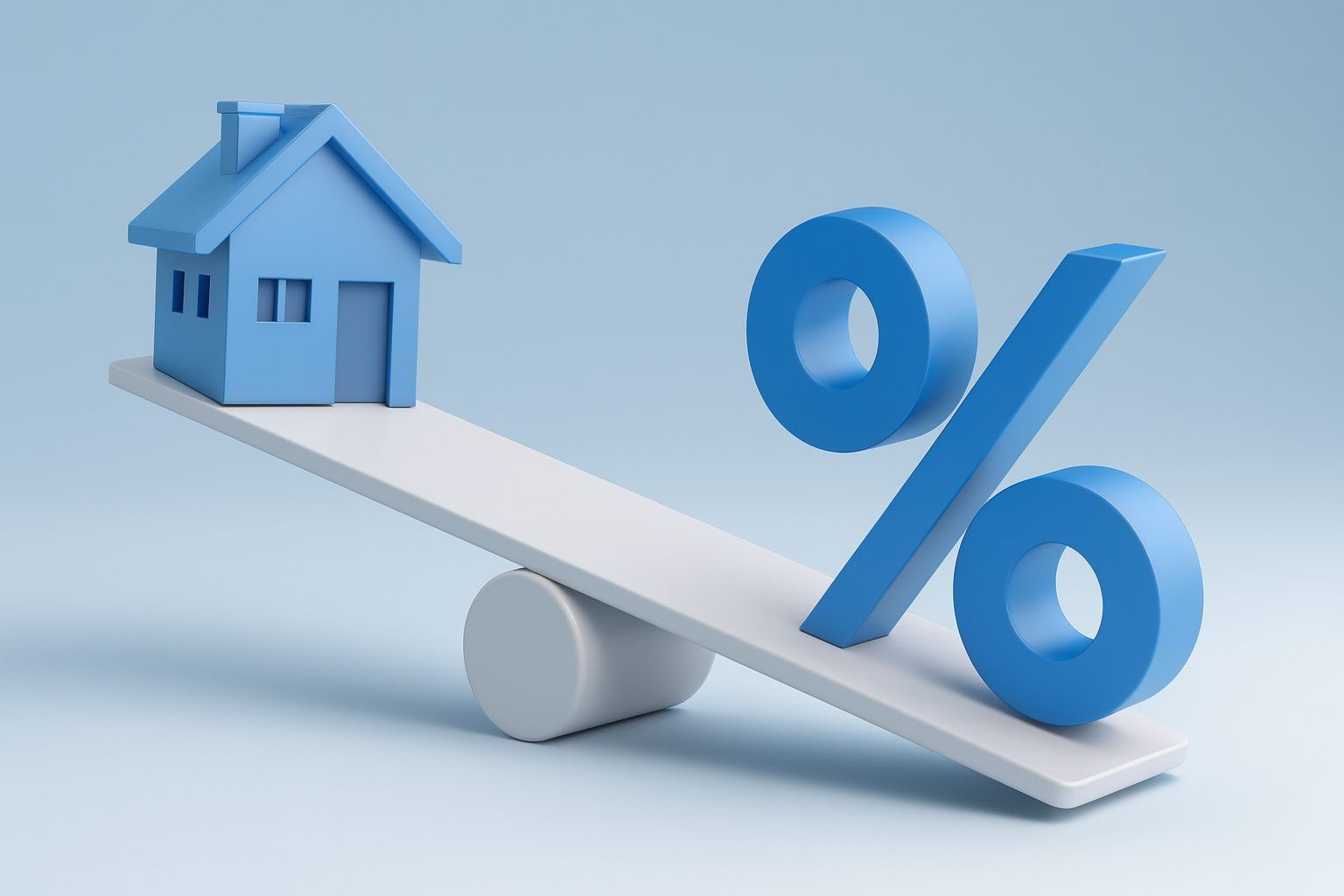Holiday homebuyers are creeping back, but mid‑6% mortgage rates and economic uncertainty keep the housing rebound fragile.
- The average 30‑year fixed U.S. mortgage rate has edged down to 6.23%, breaking a three‑week climb and moving back toward its lowest level in more than a year. [1]
- Purchase mortgage applications jumped to their highest level in over two years, even as rates on new loans hovered around 6.40% and overall mortgage demand was essentially flat. [2]
- Markets now price roughly an 85% chance of a Federal Reserve rate cut at the December 9–10 meeting, but experts warn that mortgage rates may not fall much further — and could even rise — after a Fed move. [3]
- Fed officials are increasingly focused on a softening job market, with some openly citing rising layoff plans as a reason to support another cut. [4]
Mortgage Rates Finally Ease — But Only Slightly
After several weeks of inching higher, U.S. mortgage rates have finally moved in borrowers’ favor, if only by a sliver.
Freddie Mac’s latest weekly survey shows the average 30‑year fixed mortgage rate slipping to 6.23%, down from 6.26% a week earlier and well below the 7.15% peak reached in mid‑May. The 15‑year fixed rate also eased to 5.51% from 5.54%. [5]
Those levels bring the typical 30‑year mortgage back near a 13‑month low around 6.17% seen four weeks ago — still far from the 3% loans of the pandemic era, but about 10% cheaper than in the spring. [6]
Behind the move: a drop in longer‑term bond yields. The 10‑year U.S. Treasury yield, the benchmark most closely tied to mortgage pricing, has fallen to roughly 4.01%, down from about 4.13% a week earlier, as investors bet heavily on another Federal Reserve rate cut in December. [7]
At the same time, average 30‑year contract rates on new applications tracked by the Mortgage Bankers Association (MBA) are slightly higher, around 6.40%, up from 6.37% and the highest since early October. Differences in survey methods and loan types explain the gap, but both measures tell the same story: mortgage rates are stuck in the mid‑6s, wobbling more than truly falling. [8]
A “Last‑Gasp” Push From Holiday Homebuyers
If you’re out touring homes this week, you’re not alone.
Data highlighted by CNBC and LinkedIn show that mortgage applications to buy a home jumped 7.6% last week, pushing the MBA’s purchase index to its highest level in more than two years. On a year‑over‑year basis, purchase applications are up about 20%, even though rates are higher than they were a year ago. [9]
Drilling down into the numbers:
- Total mortgage application volume — purchases plus refinances — was essentially flat, up just 0.2% for the week.
- Purchase applications rose 8% week‑over‑week and 20% compared with the same week in 2024, driven by buyers trying to secure slightly cheaper loans.
- Government‑backed loans (FHA, VA and USDA), a favorite for first‑time and lower‑down‑payment buyers, jumped about 9%, their best weekly performance since 2023. [10]
CNBC’s report characterizes this as a “last‑gasp effort before the holidays”: buyers who have been watching rates for months are stepping in before listings go quiet for December, even though borrowing costs are still historically elevated.
Yet the fact that overall volume barely budged underscores how fragile housing demand remains. Current homeowners with low‑3% or low‑4% mortgages see little reason to refinance, and many would‑be move‑up sellers are “rate‑locked” into their existing homes. The modest dip in rates is loosening the market at the margins, not unleashing a broad wave of buyers.
Why a Weak Job Market Is Pulling Mortgage Rates Down
The key driver of the latest decline in mortgage rates isn’t a sudden victory over inflation — it’s growing concern about the labor market.
Federal Reserve officials have become noticeably more vocal about job risks in recent weeks:
- Fed Governor Christopher Waller said firms are increasingly talking about layoffs rather than just hiring freezes, arguing that the central bank should put more weight on employment risks and back another quarter‑point rate cut at the December meeting. [11]
- At their October meeting, policymakers cut the federal funds rate for the second time this year, lowering the target range to 3.75%–4% and ending “quantitative tightening” — a move that should reduce upward pressure on longer‑term yields, including mortgages. [12]
- Analysis from Bankrate and others highlights a “worst of both worlds” environment: inflation still above the Fed’s 2% goal, but job seekers facing the slowest hiring pace in years and staying unemployed longer. [13]
A softer job market typically pulls bond yields lower because investors expect slower growth and, eventually, lower inflation. That is exactly what’s happening now: as recession risks and layoff talk rise, money has flowed into Treasuries, nudging yields — and therefore mortgage rates — down.
But there’s a catch for households: rate cuts driven by job worries aren’t the “celebratory” kind. They signal that the economy is losing momentum, not that all is well. Lower borrowing costs may help buyers qualify for homes, but a weaker labor market also raises the risks of stagnant wages or job loss.
December Fed Cut Back in Play — But Don’t Expect 3% Mortgages Again
A pivotal piece of the story this week is the rapid shift in expectations for the Federal Reserve’s December meeting.
An Investopedia analysis notes that traders are now assigning nearly an 85% probability that the Fed will cut its benchmark rate by another 0.25 percentage points on December 10, after having been split on that outcome just days earlier. [14]
Fresh commentary from New York Fed President John Williams and other policymakers, along with soft economic data, has led Wall Street firms such as J.P. Morgan and Goldman Sachs to pull forward their expectations and call for a December move rather than a wait‑and‑see stance into January. [15]
However, a Fed cut does not automatically mean lower mortgage rates — and recent history proves it:
- After the Fed’s rate reductions in September and October, average 30‑year mortgage rates actually rose, even though short‑term borrowing costs fell. [16]
- Between September and December 2024, the Fed lowered its policy rate by a full percentage point, yet by January the typical 30‑year mortgage rate was roughly 1.25 percentage points higher than before those cuts. [17]
That disconnect stems from how mortgages are priced. The Fed directly controls overnight rates, but mortgage rates follow the 10‑year Treasury yield and broader investor expectations about growth, inflation and future Fed moves. If markets think rate cuts might stoke inflation or prolong it, longer‑term yields — and mortgage rates — can rise even as the Fed is easing.
Looking ahead, forecasts cited by Investopedia suggest 30‑year mortgage rates are likely to hover in the low‑6% range through late 2026, potentially dipping just below 6% next year but not revisiting the ultra‑low levels of the late 2010s and early pandemic years. [18]
How Fed Policy Is Quietly Helping Housing Affordability
Even if a December cut delivers only modest relief on rates, the Fed’s broader policy shift is already supporting housing affordability at the margins.
In October, the central bank not only lowered its benchmark rate but also decided to end quantitative tightening (QT) — the process of shrinking its balance sheet by allowing bonds to roll off without reinvestment. That policy had been a steady headwind for longer‑term interest rates, including mortgages. [19]
With QT ending on December 1, the Fed is removing one source of upward pressure on mortgage costs. Combined with slower inflation and weaker job growth, this change has:
- Contributed to a gradual decline in mortgage rates since late May. [20]
- Helped existing‑home sales tick higher in October compared with a year earlier, especially in the Midwest and South, where improvements in affordability are most visible. [21]
That doesn’t mean the housing market is roaring back. Homebuilder sentiment remains cautious, inventories are tight in many metros, and years of rapid price gains have left affordability stretched, particularly for first‑time buyers. But compared with the rate shock of 2023–2024, today’s environment is slowly becoming less hostile to would‑be homeowners.
What Today’s Mortgage Landscape Means for Buyers and Owners
For households trying to make sense of all this, the headline is simple: we’re in a mid‑6% world, not a 3% world — and that’s unlikely to change soon. Here’s how to navigate it.
1. If you’re planning to buy in the next 6–12 months
- Don’t wait for 3–4% rates. Most credible forecasts point to rates staying around the low‑6s, maybe high‑5s, over the next couple of years. Betting on a return to pandemic‑era lows could mean missing out on the right home entirely. [22]
- Use today’s dip strategically. A move from 7.0% to 6.2–6.4% can meaningfully lower your monthly payment or increase your price range, especially in high‑cost markets. Run the numbers with your lender, then decide whether to lock. [23]
- Focus on fundamentals: your credit score, down payment, debt‑to‑income ratio and emergency savings. Those matter more to approval odds than tiny week‑to‑week rate moves.
2. If you already own a home
- Refinancers: If your current rate starts with a 7 or higher, today’s market might offer a worthwhile refinance opportunity even if rates don’t fall much further. Remember you can refinance again later if we see a bigger drop.
- Move‑up or downsize sellers: The “rate lock‑in” effect is real, but the gradual easing in rates plus stronger purchase demand suggests more serious buyers are out there, especially at price points supported by FHA/VA financing. Pricing realistically remains critical. [24]
3. If you’re worried about your job
- Rate cuts prompted by job‑market weakness are a reminder to protect your personal balance sheet:
- Build or replenish an emergency fund covering at least several months of essential expenses. [25]
- Avoid stretching to the absolute maximum a lender will approve; leave room in your budget in case income falls or expenses rise.
- If your industry is sensitive to tariffs, tech disruption or government spending, be especially cautious about taking on a new mortgage right now.
Numbers to Watch Between Now and the Fed Meeting
The next two weeks will be crucial for both mortgage rates and Fed policy. Key indicators:
- Weekly Freddie Mac rate survey – Will the average 30‑year rate hold near 6.2% or drift lower? [26]
- MBA mortgage applications (weekly) – Do purchase applications stay near their new two‑year high, or was this week’s spike a one‑off holiday rush? [27]
- The Fed’s December 9–10 meeting – Markets are pricing in an 85% chance of a quarter‑point cut, but a surprise hold or more hawkish tone could push mortgage rates back up. [28]
- Labor‑market data after the shutdown‑related delays – Any sign that layoffs are accelerating or hiring is deteriorating will reinforce the case for cuts and could nudge mortgage rates lower — though at the cost of a shakier economy. [29]
For now, the message from the bond and housing markets is cautiously optimistic: mortgage rates are off their highs, buyers are tip‑toeing back in, and the Fed is leaning toward more support. But until inflation is firmly under control and the labor market finds a new equilibrium, any relief for borrowers is likely to be incremental — not dramatic.
References
1. www.registercitizen.com, 2. www.linkedin.com, 3. www.investopedia.com, 4. www.reuters.com, 5. www.registercitizen.com, 6. www.registercitizen.com, 7. www.registercitizen.com, 8. www.linkedin.com, 9. www.linkedin.com, 10. www.linkedin.com, 11. www.reuters.com, 12. www.federalreserve.gov, 13. www.bankrate.com, 14. www.investopedia.com, 15. www.reuters.com, 16. www.investopedia.com, 17. www.investopedia.com, 18. www.investopedia.com, 19. www.homes.com, 20. www.homes.com, 21. www.homes.com, 22. www.investopedia.com, 23. www.registercitizen.com, 24. www.linkedin.com, 25. www.bankrate.com, 26. www.registercitizen.com, 27. www.linkedin.com, 28. www.reuters.com, 29. www.reuters.com










